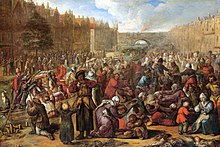Siege of Suffering
| date | October 1573 to October 3, 1574 |
|---|---|
| place | Suffer |
| output | United Netherlands victory |
| Parties to the conflict | |
|---|---|
| Commander | |
|
|
|
Western Europe
Oosterweel - Dahlen - Heiligerlee - Jemgum - Jodoigne - Le Quesnoy - Brielle - Mons - Goes - 1. Mechelen - Naarden - Middelburg - Haarlem - Alkmaar - Geertruidenberg - Leiden - Delft - Valkenburg - Mooker Heide - Schoonhoven - Zierikzee - 1. Antwerp - Gembloux - Rijmenam - 1. Deventer - Borgerhout - 1. Maastricht - 2. Mechelen - 1. Steenwijk - Kollum - 1. Breda - Noordhorn - Niezijl - Lochem - Lier - Eindhoven - Steenbergen - Ghent - Aalst - 2. Antwerp - IJsseloord - Empel - Boksum - 1. Grave - 1. Venlo - Axel - Neuss - 1. Rheinberg - Zutphen - 1. Sluis - 1. Bergen op Zoom - 2. Geertruidenberg - 2. Breda - 2. Zutphen - 2. Deventer - Delfzijl - Knodsenburg - 1. Hulst - Nijmegen - Rouen - Caudebec - 2. Steenwijk - 1. Coevorden - 3. Geertruidenberg - 2. Coevorden - Groningen - Huy - 1. Groenlo - Lippe - Calais - 2. Hulst - Turnhout - 2. Rheinberg - 1. Moers - 2. Groenlo - Bredevoort - Enschede - Ootmarsum - 1. Oldenzaal - 1. Lingen - 1. Schenckenschans - Zaltbommel - Rees - San Andreas - Nieuwpoort - 3. Rheinberg - Ostend - 1. 's-Hertogenbosch - 2. Grave - Hoogstraten - 3. Sluis
Twelve Years Peace
2. Lingen - 3. Groenlo - Aachen - Jülich - 2. Bergen-op-Zoom - Fleurus - 3. Breda - 2. Oldenzaal - 4. Groenlo - 2. 's-Hertogenbosch - Slaak - 2. Maastricht - Leuven - 2. Schenkenschans - 4. Breda - 2. Venlo - Kallo - 3. Hulst
European waters
Vlissingen - Borsele - Haarlemmermeer - Zuiderzee - Scheldt - Lillo - Ponta Delgada - Bayona Islands - Gulf of Almería - 1st Cadiz - Azores - Strait of Dover - 2nd Sluis - 1st Cape St. Vincent - 1st Gibraltar - 2nd Gibraltar - 2nd Cadiz - Lizard Point - Dunkirk - Calais - Downs - 2nd Cape St. Vincent - 2nd St. Martin
America
Bahia - Matanzas - St. Martin - San Juan - Abrolhos - Pernambuco - South Chile
East Indies
Playa Honda - 1st San Salvador - 2nd San Salvador - La Naval de Manila - Puerto de Cavite
During the siege of Leiden in the Netherlands in 1573 and 1574, the insurgent population withstood the pressure of the Spanish governor and his troops.
history
The Netherlands fought for independence from Spain in the Eighty Years War ; In 1572, Leiden joined this uprising. The Duke of Alba , the Spanish governor of the Netherlands, had taken the city of Haarlem in a long siege .
At the end of 1573 he marched against Zeeland and, from October 31st, enclosed Leiden with his troops. Don Luis de Zúñiga y Requesens continued the siege in Alba's sense. After Ludwig von Nassau approached with a relief army, the Spaniards gave up the siege to attack Nassau's troops. After the lost battle on the Mooker Heide on April 14, 1574, the siege by Francisco de Valdez was continued in May 1574 .
In the meantime, the inhabitants had created a clear field of fire through the destruction in the run-up to the city. But they only partially destroyed the Spanish jumps. Nor had it been possible to get enough food. The citizens had also refused to accept the English soldiers offered to them by William of Orange .
The Spaniards drew their siege lines ever closer to the city and cut off Leiden from any supply. Bread prices rose rapidly and the rations soon had to be cut. The besiegers were determined to starve the city and avoided costly attacks. The citizens rejected the request to hand it over at the end of July. All attempts at relief failed, as did the supply of the city. 6000 people, a third of the population, died.
William of Orange called the Estates of the Province of Holland together. They decided to flood the area around Leiden. In September, the Geusen damaged the dykes at the Maas estuary in Rotterdam , flooding the polderland and driving water to Leiden during the night of October 3rd. The Spanish troops had to flee, so that the siege ended. October 3rd is still celebrated in Leiden today.
Prince William of Orange thanked the city of Leiden for their perseverance in the struggle for independence. He gave her the first university in the free Netherlands.
reception
A street, a park and a statue in it are reminiscent of Mayor van der Werff in Leiden. The Hutspot will also be served all over Leiden on October 3rd. The university continues its founding year in the coat of arms, with reference to the freedom of the Netherlands.
literature
- Hanns Eggert Willibald von der Lühe (ed.): Military conversation lexicon . tape 4 . Leipzig 1834, p. 650 ff .
Individual evidence
- ↑ Het Nederland of Belgium nostrum ( Memento of March 9, 2014 in the Internet Archive ) Leiden University on the uprising in the Netherlands (Dutch)

